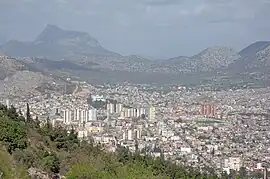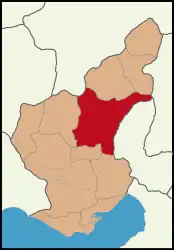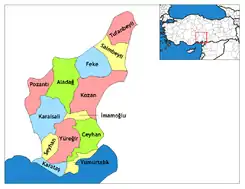Kozan | |
|---|---|
District and municipality | |
 View from Kozan Castle | |
 Map showing Kozan District in Adana Province | |
 Kozan Location in Turkey | |
| Coordinates: 37°27′N 35°48′E / 37.450°N 35.800°E | |
| Country | Turkey |
| Province | Adana |
| Government | |
| • Mayor | Kazım Özgan (AKP) |
| Area | 1,903 km2 (735 sq mi) |
| Elevation | 120 m (390 ft) |
| Population (2022)[1] | 132,703 |
| • Density | 70/km2 (180/sq mi) |
| Time zone | TRT (UTC+3) |
| Postal code | 01510 |
| Area code | 0322 |
| Website | www |
Kozan, formerly Sis (Armenian: Սիս), is a municipality and district of Adana Province, Turkey.[2] Its area is 1,903 km2,[3] and its population is 132,703 (2022).[1] It is 68 kilometres (42 miles) northeast of Adana, in the northern section of the Çukurova plain. The Kilgen River, a tributary of the Ceyhan, flows through Kozan and crosses the plain south into the Mediterranean. The Taurus Mountains rise up sharply behind the town.
Sis was the capital of the Armenian Kingdom of Cilicia, today's Sis (ancient city), now called Kozan Kalesi, was built on a long rocky ridge in the center of the modern city.[4]
The population of the city has grown rapidly in recent years, from 15,159 in 1960, to 54,451 in 1990, to 72,463 in 2007 and to 74,521 in 2009 (census figures).
Names
The oldest known name is Sis or Siskia. Under the Roman Empire, it was for a time named Flavias or Flaviopolis.[5] The Greek version of the older name, Σίσιον Sision, came back into use in the later Byzantine period.[6] In Armenian, it is called Sis Սիս or Sissu.
Kozan (Ottoman Turkish: قوزان, romanized: qōzān) was originally the name of the administrative division the town Sis was a part of. This name originates from the Qōzānoğlu dynasty of derebeys that controlled the region from 1689 to 1865.[7]
History
Middle Ages
_p153_-_VUE_DE_SIS.jpg.webp)
_p197_TOWN_AND_FORTRESS_OF_SIS.jpg.webp)
In 704, Sis was besieged by the Arabs, but relieved by the Byzantines. The Abbasid caliph al-Mutawakkil took it and refortified it, but it soon returned to Byzantine hands. It was rebuilt in 1186 by Leo II, king of the Armenian Kingdom of Cilicia, one of the Rupenide dynasty who made the city the capital of the Kingdom of Lesser Armenia (from 1186 till 1375). During the Crusade the catholicate returned to Sis in 1294, and remained there 150 years.[8]
In 1266 Sis, the capital of the Armenian Kingdom of Cilicia, was captured and damaged by the Egyptian Mamluks led by Baibars. al-Said Barakah sent Qalawun to attack the city in 1277, but in 1375, Sis was taken and demolished by the Ramadanids, under the flag of the Mamluke Sultan of Egypt. The town never recovered its prosperity, not even when it passed into the power of the Ottomans in 1516.
Ecclesiastical history
Sis had an important place in ecclesiastical history both the Armenian Apostolic Church and as a Roman Catholic titular see. It is first mentioned in Theodoret's life of St. Simeon Stylites.
In the Middle Ages, Sis was the religious center of Christian Armenians, until the Armenians moved the seat of Catholicos back to Vagharshapat (Echmiadzin), in Armenia. Lequien (II, 899) gives the names of several bishops of Sis, before and after Gregory IX.
Even prior to the Armenian Kingdom of Cilicia, Sis was an episcopal see and several names of bishops and patriarchs can be found in the literature:
- Alexander, later Bishop of Jerusalem and founder of the famous library of the Holy Sepulchre in the third century
- Nicetas, present at the First Council of Nicaea in 325
- John, who lived in 451;
- Andrew in the sixth century
- George (681)
- Eustratus, Patriarch of Antioch about 868
In 1441, Sis having fallen from its high estate, the Armenian clergy proposed to remove the see, and on the refusal of the Catholicos of the day, Gregory IX, installed a rival, namely Kirakos I Virapetsi (Kirakos of Armenia) at Echmiadzin, who, as soon as Selim I had conquered Greater Armenia, became the more widely accepted of the two by the Armenian church in the Ottoman Empire.[8]
The Catholicos of Sis (of the Holy See of Cilicia) maintained himself nevertheless, with under his jurisdiction several bishops, numerous villages and convents, and was supported in his views by the Catholic Pope up to the middle of the 19th century, when the patriarch Nerses, declaring finally for Echmiadzin, carried the government with him. In 1885, Sis tried to declare Echmiadzin schismatic, and in 1895 its clergy took it on themselves to elect a Catholicos; but the Porte annulled the election, and only allowed it six years later upon Sis renouncing its pretensions to independence. That Catholicos had the right to prepare the sacred myron (oil) and to preside over a synod, but was in fact not more than a metropolitan, and regarded by many Armenians as schismatic.[8]
Ottoman period
In the Ottoman period, Kozan was in the sanjak of Adana, and the seat of the kaza of Kozan.[9] Ottoman archives show that Devşirme system was implemented in Kozan. However there is evidence that the locals resisted the practise. In 1564, for example, villagers from Sis came to the Ottoman capital Istanbul and kidnapped their children back.[10] From 1689 to 1865,[7] the region was under the control of Kozanoğulları, a family of feudal lords. While there are various theories about their history and origin,[11] they claimed descent from Turkmen tribes,[12] and Ahmed Cevdet Pasha wrote that they were descended from the Arık tribe of Warsaks.[7]
Modern
At the turn of the twentieth century, the town's population was 8,000, about 5,600 of which were Armenians.[13] They were all deported during the course of the Armenian genocide. Kozan was occupied by France between March 8, 1919 - June 2, 1920 during the Turkish War of Independence. After Turkey was declared a republic, Kozan was a province, compromising the districts of Kozan, Kadirli, Feke and Saimbeyli between 1923 and 1926.
Composition
There are 103 neighbourhoods in Kozan District:[14]
- Acarmantaş
- Ağlıboğaz
- Akarca
- Akçalıuşağı
- Akdam
- Akkaya
- Alapınar
- Andıl
- Arslanlı
- Arslanpaşa
- Aydın
- Ayşehoca
- Bağlar
- Bağözü
- Bağtepe
- Boztahta
- Bucakköy
- Bulduklu
- Çamdere
- Çamlarca
- Çanaklı
- Çandık
- Çelenuşağı
- Çobanpınarı
- Çokak
- Çukurören
- Çulluuşağı
- Cumhuriyet
- Çürüklü
- Damyeri
- Dikilitaş
- Dilekkaya
- Doğanalanı
- Duraluşağı
- Durmuşlu
- Düzağaç
- Enizçakırı
- Ergenuşağı
- Eskikabasakal
- Eskimantaş
- Faydalı
- Ferhatlı
- Gazi
- Gedikli
- Gökçeyol
- Gökgöz
- Görbeyaz
- Güneri
- Hacıbeyli
- Hacımirzalı
- Hacıuşağı
- Hamamköy
- İdemköy
- Ilıcaköy
- Işıkkaya
- Işıklı
- Kabaktepe
- Kahveli
- Kalkumaç
- Kapıkaya
- Karabucak
- Karacaoğlan
- Karacaören
- Karahamzalı
- Karanebili
- Kemer
- Kıbrıslar
- Kızıllar
- Kızlarsekisi
- Köseli
- Kuytucak
- Kuyubeli
- Kuyuluk
- Mahmutlu
- Mahyalar
- Marankeçili
- Minnetli
- Orçan
- Örendere
- Oruçlu
- Özbaşı
- Pekmezci
- Postkabasakal
- Salmanlı
- Şerifli
- Şevkiye
- Taş
- Tavşantepe
- Tepecikören
- Tufanlı
- Tufanpaşa
- Turgutlu
- Türkeli
- Turunçlu
- Varsaklar
- Velicanlı
- Yanalerik
- Yarımoğlu
- Yassıçalı
- Yeniköy
- Yukarıkeçili
- Yüksekören
- Zerdali
Kozan today
Today Kozan is a city surrounded by vineyards, gardens and groves of cypress, sycamore fig, orange and lemon trees. In summer the great heat (40 plus degrees Celsius or 104 plus degrees Fahrenheit) compels the inhabitants to desert Kozan, retreating to cool off in the wooded higher ground.
Climate
Kozan has a hot-summer Mediterranean climate (Köppen climate classification Csa). The highest recorded temperature was on 13 August 2023 at 48.4 °C (119.1 °F).
| Climate data for Kozan | |||||||||||||
|---|---|---|---|---|---|---|---|---|---|---|---|---|---|
| Month | Jan | Feb | Mar | Apr | May | Jun | Jul | Aug | Sep | Oct | Nov | Dec | Year |
| Mean daily maximum °C (°F) | 14.0 (57.2) |
15.2 (59.4) |
18.8 (65.8) |
23.7 (74.7) |
28.4 (83.1) |
32.6 (90.7) |
35.6 (96.1) |
36.1 (97.0) |
33.9 (93.0) |
28.6 (83.5) |
21.6 (70.9) |
15.9 (60.6) |
25.4 (77.7) |
| Mean daily minimum °C (°F) | 5.8 (42.4) |
4.7 (40.5) |
7.9 (46.2) |
11.4 (52.5) |
14.7 (58.5) |
18.5 (65.3) |
21.9 (71.4) |
22.1 (71.8) |
19.2 (66.6) |
14.9 (58.8) |
10.2 (50.4) |
6.2 (43.2) |
13.1 (55.6) |
| Average precipitation mm (inches) | 110 (4.3) |
91 (3.6) |
97 (3.8) |
90 (3.5) |
71 (2.8) |
45 (1.8) |
14 (0.6) |
13 (0.5) |
22 (0.9) |
54 (2.1) |
66 (2.6) |
122 (4.8) |
795 (31.3) |
| Source: Climate-data.org | |||||||||||||
Notable natives
- Nerses Balients (fl. early 14th century), Armenian ecclesiastical figure, politician, historian
- Grigor Khul (12th century), Armenian musician
- Manase Sevak (1897–1967), Armenian biochemist and public figure, member of New York Academy of Sciences and Soviet Armenia's Academy of Sciences
- Grigor Kyulyan (1912–1974), Armenian writer
- İmren Aykut (born 1940), Turkish female economist, trade unionist, politician and former government minister
Things to see
Today ruins of churches, convents, castles and palaces may be seen on all sides. The lofty castle and the monastery and church built by Leo II, and containing the coronation chair of the kings of Cilician Armenia, were still noteworthy up until the Armenian genocide.
Gallery
 Street view of Kozan
Street view of Kozan Grand Mosque of Kozan
Grand Mosque of Kozan

 Kozan Velicanlı District Sin Monastery
Kozan Velicanlı District Sin Monastery
 General view of Kozan
General view of Kozan
See also
- Kozan Dam on the Kilgen River, 8 km (5 mi) north of Kozan
Notes
- 1 2 "Address-based population registration system (ADNKS) results dated 31 December 2022, Favorite Reports" (XLS). TÜİK. Retrieved 12 July 2023.
- ↑ Büyükşehir İlçe Belediyesi, Turkey Civil Administration Departments Inventory. Retrieved 12 July 2023.
- ↑ "İl ve İlçe Yüz ölçümleri". General Directorate of Mapping. Retrieved 12 July 2023.
- ↑ "Castles.nl - Sis Castle". www.castles.nl. Retrieved 21 April 2018.
- ↑ 1911 Encyclopædia Britannica, s.v. 'Sis'
- ↑ William Mitchell Ramsay, The Historical Geography of Asia Minor, p. 385
- 1 2 3 Gould 2012.
- 1 2 3 Chisholm, Hugh, ed. (1911). . Encyclopædia Britannica (11th ed.). Cambridge University Press.
- ↑ Houshamadyan. "Maps - Vilayet of Adana - Sandjak of Sis :: Houshamadyan - a project to reconstruct Ottoman Armenian town and village life". www.houshamadyan.org. Retrieved 21 April 2018.
- ↑ Yılmaz, Gülay (2015-12-01). "The Devshirme System and the Levied Children of Bursa in 1603-4". Belleten (in Turkish). 79 (286): 901–930. doi:10.37879/belleten.2015.901. ISSN 0041-4255.
- ↑ Eberhard, Wolfram (1953). Nomads and Farmers in Southeastern Turkey, Problems of Settlement. Brill. p. 45.
- ↑ Bearman et al. 2012.
- ↑ Kévorkian, Raymond H. and Paul B. Paboudjian, Les Arméniens dans l’Empire Ottoman à la veille du génocide. Paris: Editions d’art et d’histoire, 1992, p. 292.
- ↑ Mahalle, Turkey Civil Administration Departments Inventory. Retrieved 12 July 2023.
References
- Chisholm, Hugh, ed. (1911). . Encyclopædia Britannica (11th ed.). Cambridge University Press.
 This article incorporates text from a publication now in the public domain: Herbermann, Charles, ed. (1913). "Flavias". Catholic Encyclopedia. New York: Robert Appleton Company.
This article incorporates text from a publication now in the public domain: Herbermann, Charles, ed. (1913). "Flavias". Catholic Encyclopedia. New York: Robert Appleton Company.
Bibliography
- Gould, A.G. (2012). "Ḳōzān". In Bearman, P.; Bianquis, Th.; Bosworth, C.E.; van Donzel, E.; Heinrichs, W.P. (eds.). Encyclopaedia of Islam, Second Edition. E. J. Brill.
- Bearman, P.; Bianquis, Th.; Bosworth, C.E.; van Donzel, E.; Heinrichs, W.P., eds. (2012). "Ḳōzān-Og̲h̲ullari̇". Encyclopaedia of Islam, Second Edition. E. J. Brill.
